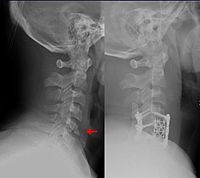
Photo from wikipedia
INTRODUCTION The COVID-19 pandemic has impacted students learning, with the time off resulting in students 'de-skilling', increasing concerns for upcoming observed structured clinical examinations. Foundation Year 1 (F1) doctors (F1s),… Click to show full abstract
INTRODUCTION The COVID-19 pandemic has impacted students learning, with the time off resulting in students 'de-skilling', increasing concerns for upcoming observed structured clinical examinations. Foundation Year 1 (F1) doctors (F1s), despite being expected to teach, rarely receive formal preparation, with COVID-19 exacerbating opportunities to practice. As such, a national orthopaedic teaching programme was designed to provide F1s with opportunities to develop their teaching skills and to synergistically teach medical students how to perform clinical orthopaedic examinations. METHODS Six weekly sessions, each delivered by two newly qualified F1 tutors, on each joint examination were delivered online via Zoom Video Communications (USA). Presession and postsession multiple choice questions (MCQs) were provided to students to assess improvement in knowledge. Anonymous feedback forms were provided to both students and tutors. RESULTS Of the 341 students that attended, 87.1% provided feedback. 86.2% felt that they had de-skilled due to time off, with a mean 15 weeks off from placement. Based on a 5-point Likert scale, students displayed a mean improvement in confidence (1.9±1.1, p<0.001) and MCQ scores (1.4±1.3, p<0.001) before and after the sessions. 91.6% and 95.3% agreed that the use of online teaching increased attendance and laid the foundation for practice. Of the six tutors, all reported improvement in confidence to teach and teaching skills. CONCLUSION We demonstrate that online delivery of clinical orthopaedic examinations is effective, increasing the knowledge and confidence of students, while providing opportunities for F1s to teach. We present our findings to encourage similar teaching programmes to be adopted at other locations and specialties, to synergistically benefit students, doctors and ultimately, patients.
Journal Title: Postgraduate medical journal
Year Published: 2022
Link to full text (if available)
Share on Social Media: Sign Up to like & get
recommendations!